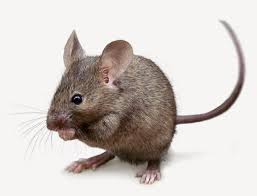Mice (Mus domesticus) have colonized the world together with man. There are many types of home – dwarf-, forest-, toss- and sleeping mice. They belong to the same group as the rats.
 An adult house mouse measures 72 to 103 mm, tail 70 to 95 millimeters. She weighs 12 to 22 grams.
An adult house mouse measures 72 to 103 mm, tail 70 to 95 millimeters. She weighs 12 to 22 grams.
Mice are omnivores with a preference for seeds, grains, nuts, as well as carrots, insects, worms, and have even soap, paper or glue on the menu. By day they eat about 3.5 grams. They can survive without drinking water, if their food contains more than 15 percent water.
They may be thirty months old, but the average is bisected by its enemies: birds of prey, owls, cat, fox and martens as weasel and stoat.
They can have 5 to 10 x / year a litter of about 8 pups. The gestation period is 19 to 21 days. They can fastly make food unfit for human consumption.
They can pass through a small crack (if not covered with mesh). Not for nothing the cat is for more than 9,500 years our favorite pet.
Avoid mice: clean up food residues. Keep all food inaccessible, suspended or in closed containers.
They do not like cats and mint (Mentha pulegium), they love nuts.
You can catch them with mousetraps, fykes of metal, or high, steep pots where they can get in but not out. (Not underestimate them!) Lead them in there with (tilting) loop board and bait.
The (edable- or fat) dormouse (Glis glis or Myoxus glis) lives in Southern and Central Europe, Northern Spain to Belgium. She is known as dormouse because seven months she is hibernating (French: dormir = sleeping). It is a rodent, a sort of grayish squirrel. This largest Dormouse in Europe has a length of 13 to 19 centimeters, and weighs between 70 and 200 grams. The bushy tail is slightly shorter than the animal itself, approximately 12 to 15 centimeters.
She was with the Ancient Romans a prized delicacy. The animals were kept and fattened with nuts, chestnuts and acorns in gliraria: specially made clay pots with air holes. When the animals were bold enough, they were slaughtered. The filling of this delicacy was made from sausage and seasoned with pepper and nuts.
Shrews (Soricidae) are a separate large family of nearly 500 different species from the order of insectivores (Eulipotyphla). This little mouse species has a pointed snout, short legs, small eyes, but good are hearing and sense of smell. Shrews have short brownish or gray hairs. Their salivary glands secrete a toxic substance.
Bats (Chiroptera, and flying foxes) are not mice. There are approximately 1,100 species of these night flyers.
April 2014 The Government of Guinea has banned the sale and consumption of bats to prevent the spread of the Ebola virus.
Under the ridge of attics you see on farms often circular or triangular holes. Because there was hay and straw, sometimes also grain stored, they were popular places for mice. The "owl holes" gave access for nighttime allies against these unwanted guests.
The early bird may get the worm, but the second mouse gets the cheese in the trap.
I trained my scholar. If I press this button, he feeds me.
